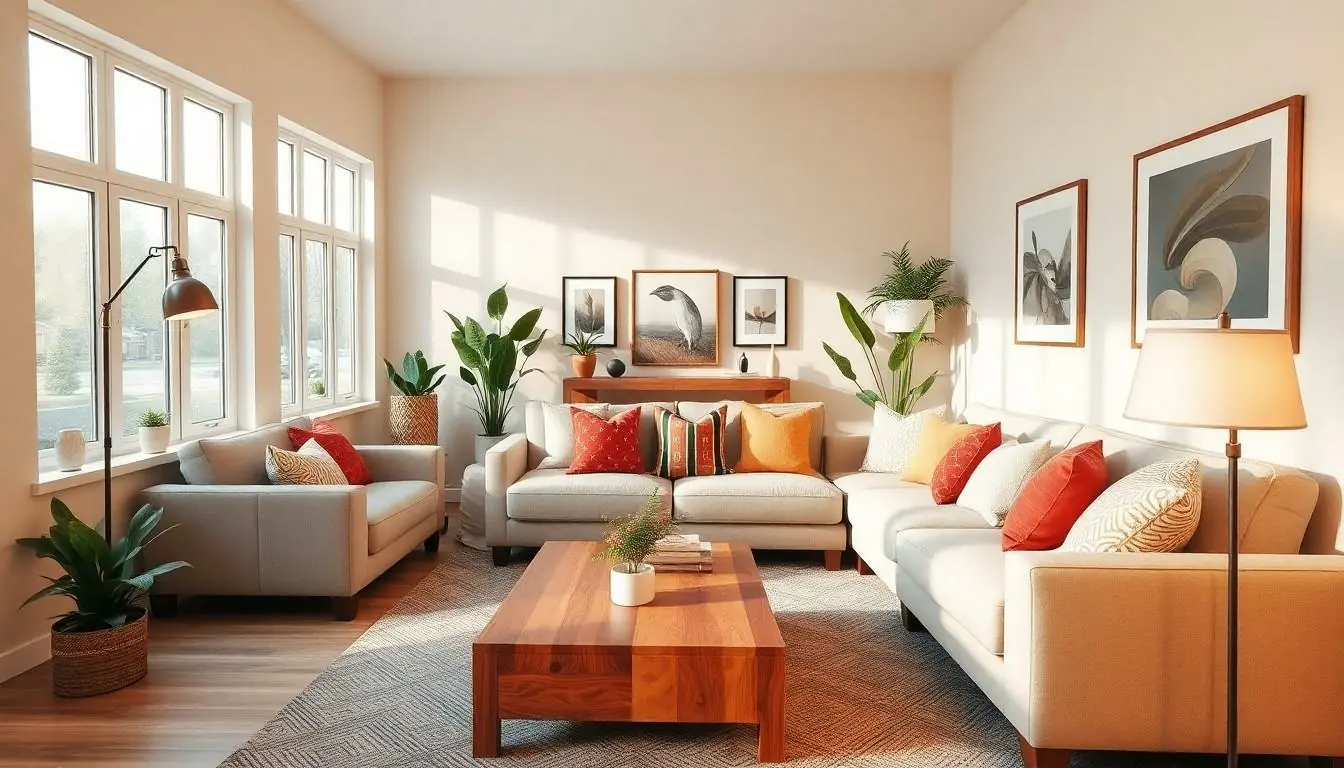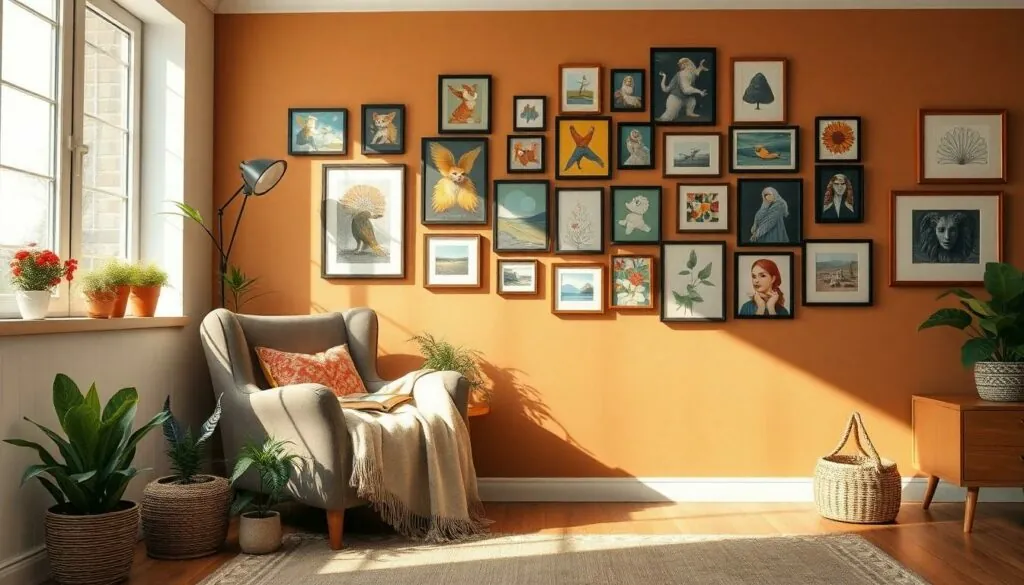Table of Contents
ToggleTransforming a house into a home is like adding the secret sauce to a bland dish—it just makes everything better. Home interior decor isn’t just about aesthetics; it’s about creating a space that reflects personality and sparks joy. Whether it’s a cozy nook for reading or a vibrant gallery wall showcasing cherished memories, the right decor can turn any room into a sanctuary.
Understanding Home Interiors Decor
Home interior decor plays a significant role in creating personal and joyful spaces. It influences the overall feel of a home, allowing individuals to express their unique style.
Importance of Home Decor
Home decor enhances the functionality of a space while also reflecting personality. Thoughtful decoration can transform a bland room into a captivating area that invites relaxation and comfort. It contributes to emotional well-being by creating environments that foster inspiration and tranquility. Personalized decor elements, such as artwork or plants, cultivate connection and joy, making living spaces truly memorable. Ultimately, home interior decor serves as a vital component in establishing a sense of belonging within a home.
Trends in Home Interiors
Current trends in home interiors focus on sustainability and minimalism. Incorporating natural materials, like wood and stone, promotes an eco-friendly aesthetic that resonates with modern values. Colors are shifting toward earthy tones, creating harmonious and calming atmospheres. Additionally, multifunctional furniture designs are gaining popularity, allowing smaller spaces to maximize utility without sacrificing style. Personalization remains paramount, influencing homeowners to mix textures and patterns that evoke personal stories and experiences. Embracing these trends can refresh any home, ensuring it reflects contemporary styles while remaining uniquely personal.
Key Elements of Home Interiors Decor

Home interior decor encompasses various elements that create inviting and personalized spaces. Understanding these key components aids in crafting a harmonious atmosphere.
Color Schemes and Palettes
Color significantly influences the mood of a room. Utilizing a balanced palette fosters harmony and warmth. Earthy tones promote tranquility, while vibrant colors energize spaces. Choosing the right hues for walls, furniture, and accessories enriches overall design. Mixing textures enhances visual interest and depth. Neutral colors often serve as a backdrop that allows accent pieces to shine. Complementary shades can create contrast and highlight design elements. Consider personal preferences when selecting colors to ensure a comfortable environment.
Furniture Selection
Furniture contributes to both aesthetics and functionality. Selecting pieces that suit lifestyle needs ensures comfort and usability. Multifunctional furniture maximizes space, particularly in smaller areas. Styles range from modern minimalism to classic elegance, allowing for a tailored approach. Evaluating the size of each item prevents overcrowding and maintains flow. Choosing durable materials guarantees longevity and ease of maintenance. Arranging furniture thoughtfully encourages conversation and enhances movement throughout the room.
Lighting Choices
Lighting plays a crucial role in setting the ambiance. Layered lighting creates depth and versatility in a space. Incorporating ambient, task, and accent lighting allows for adaptability throughout day and night. Selecting fixtures that complement decor style enhances visual cohesion. Natural light also elevates mood, so consider window treatments that maximize brightness. Dimmers provide control over lighting intensity, allowing personalization of atmosphere. Thoughtful placement of lighting fixtures highlights architectural features or key decor elements.
Tips for Effective Home Interiors Decor
Effective home interior decor transforms spaces while reflecting personal style. Attention to detail boosts functionality and aesthetics.
Maximizing Small Spaces
Small spaces benefit from strategic decor choices. Opt for multifunctional furniture that serves various purposes, such as storage ottomans that double as seating. Utilize vertical space with shelves to keep floors clear. Mirrors create an illusion of depth, making rooms appear larger. Favor light colors on walls and furniture, as these shades enhance brightness and openness. Lastly, define areas with rugs to delineate spaces, helping to create a sense of organization.
Creating a Cohesive Look
A cohesive decor theme enhances the overall harmony of a home. Begin with a unifying color palette that connects each room while allowing for personal expression. Complementary furnishings create visual balance, while consistent materials, like wood or metal, unify the space. Consider varying textures to add depth without sacrificing cohesion. Incorporate artwork and decor items that share a common style or theme, linking different areas naturally. Lastly, balance large pieces with smaller accents to avoid overwhelming the eye, ensuring comfort and tranquility throughout.
Popular Home Interiors Decor Styles
Home interiors decor encompasses various styles, each offering unique charm and personalization. Explore some of the most popular decor styles that enhance living spaces.
Modern and Contemporary
Modern decor emphasizes clean lines and functional design. Angular furniture often features neutral color palettes, creating a calm atmosphere. It’s common to incorporate metals and glass in accessories, which complement wooden pieces. Contemporary decor, while similar, adapts to current trends, often embracing bold colors and innovative patterns. Designers frequently mix textures, pairing soft fabrics with sleek surfaces for visual interest. Open spaces define this style, encouraging flow and interaction throughout the home.
Rustic and Farmhouse
Rustic decor captures the essence of nature, showcasing raw materials like wood and stone. Farmhouse style highlights warmth and comfort, often featuring distressed furniture and vintage accents. Earthy tones dominate this aesthetic, creating an inviting ambiance. Decorative elements such as mason jars and woven baskets add authenticity. Large, communal furnishings often serve as central gathering points, encouraging family interaction. This decor style thrives on simplicity, blending classic and modern elements for a timeless look.
Minimalist and Scandinavian
Minimalist decor embodies simplicity and functionality. Neutral colors dominate, often accented with soft textures, allowing space to breathe. Essential furniture pieces maximize utility while maintaining an uncluttered appearance. Scandinavian style shares this focus on simplicity but incorporates warmth through natural materials. Light woods and cozy textiles create a welcoming atmosphere. Subtle pops of color add interest without overwhelming the senses. Both styles prioritize quality over quantity, promoting a serene environment that fosters mindfulness and reflection.
Home interior decor plays a crucial role in shaping a space that resonates with individuality and warmth. By thoughtfully selecting decor elements and embracing current trends like sustainability and minimalism, homeowners can create environments that inspire and nurture.
The right combination of color, furniture, and lighting not only enhances aesthetics but also elevates functionality. Whether opting for modern elegance or rustic charm, each style offers a unique way to express personal stories and foster connections.
Ultimately, a well-decorated home becomes a sanctuary that reflects its inhabitants, making it a place of comfort and joy.





